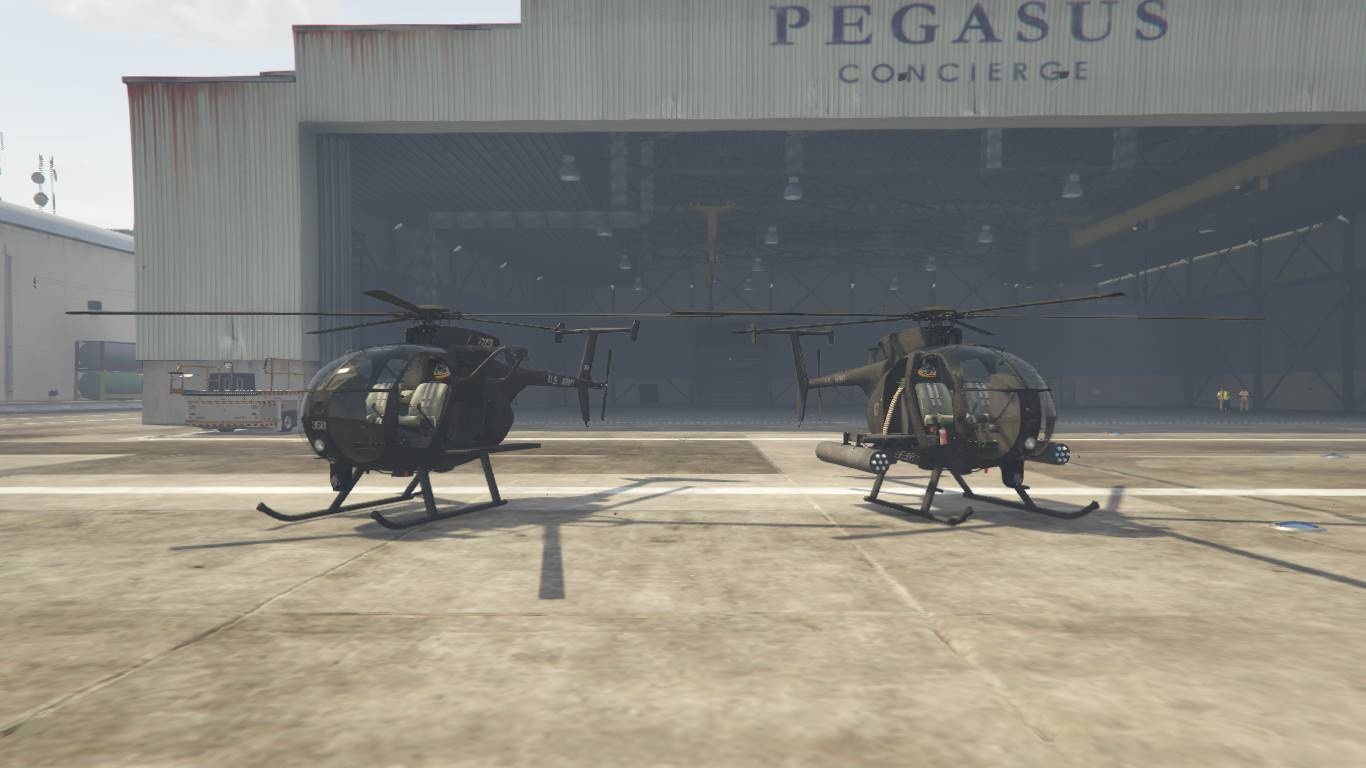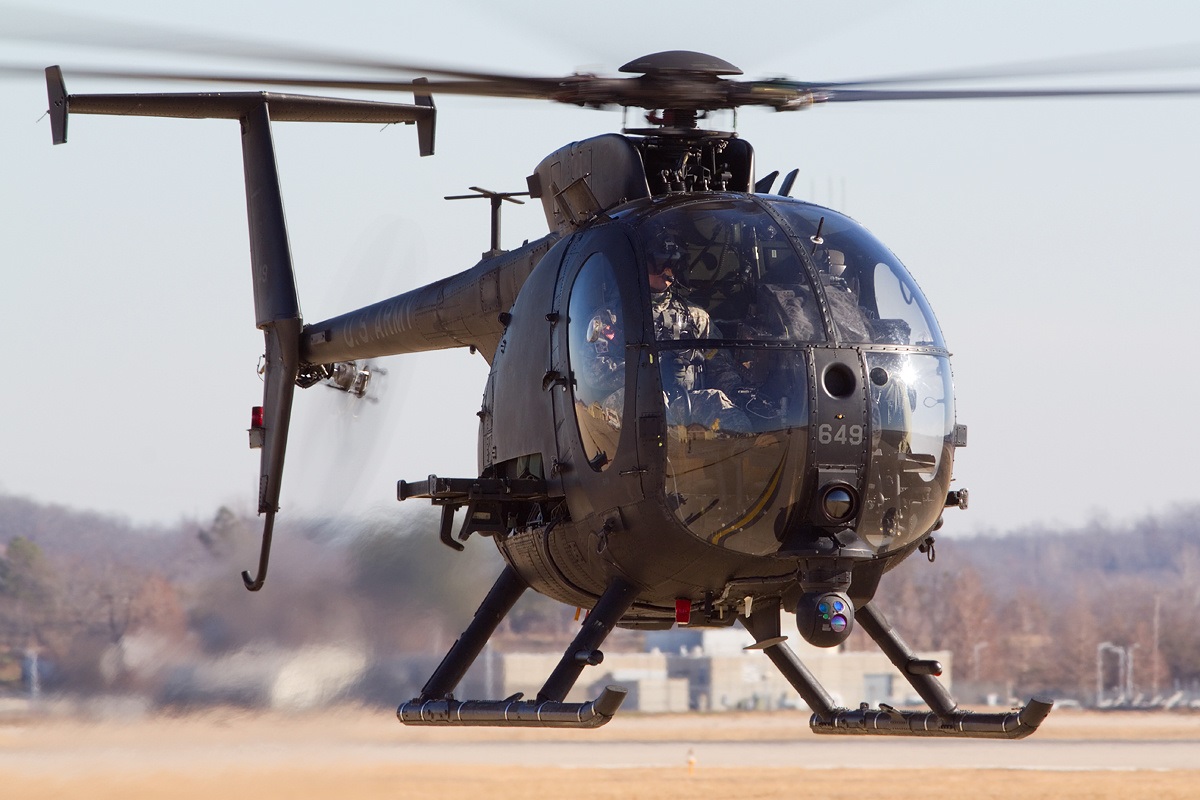Little Bird Ah6 - Boeing will begin production of the AH-6i International variant of the Little Bird light attack helicopter this year. (Photo: Bill Carey)
Boeing Defense will begin production of the AH-6i Little Bird light attack and reconnaissance helicopter in Mesa, Arizona by the end of the year. The manufacturer declined to name the first buyer, which the US military previously identified as the Saudi National Guard. The latter agency will acquire 24 international small birds through Foreign Military Sales (FMS).
Little Bird Ah6

"We're starting a production line this year ... and this aircraft will be in production," Bradley Rounding, Boeing's attack helicopter business development manager, told reporters in Philadelphia on May 22. "So this is an important event for our team." Boeing expects to build two helicopters per month and complete deliveries to launch customers by December 2017.
Mh 6/ah 6 Little Bird Marine For Gta 5
Mesa-based MD Helicopters, spun out of the former McDouglas Commercial Helicopter division, will provide the airframe for the first 24 helicopters, Goling said. Boeing will perform final assembly, flight test and delivery.
The Army last year awarded a $234 million FMS contract to Boeing to supply AH-6is to Saudi Arabia. The Little Bird International variant was included in a major arms deal between the US and Saudi authorities in 2010. "We have several others we are working on and we are excited about the future possibilities."
The AH-6i borrows from the development of Boeing's AH-64E Apache Guardian attack helicopter and the A/MH-6M Littlebird used by the US special forces. The integrated digital cockpit is derived from the Apache, with a "state-of-the-art" mission computer that manages weapon systems and locations, Goling said. The production aircraft is equipped with an L-3 Wescam MX-15Di image turret with laser range finder and designator, but its open system architecture supports a variety of sensors.
There are two weapons magazines on each side of the aircraft, allowing for a combination of weapons, including an M-134 minigun, .50 caliber GAU-19B machine gun, M260 seven-shot rocket pods and four semi-active laser grenades. Launcher missiles are included. They were picked up from special forces helicopters. "They have developed and qualified all the weapons on the aircraft," Goling said. "When we developed this program, we reached back to weapons that were already capable of special operations and we advanced them into an airframe that we eventually called the AH-6i."
Mh 6 Little Bird
Wing stores also support 30-litre conformal fuel tanks on each side, providing an additional 60 liters of fuel, or approximately two and a half hours of endurance. Another optional AH-6i has a 63-gallon "Goliath" internal auxiliary fuel tank.
Boeing conducted developmental testing on an AH-6X production standard helicopter before starting the production line. The first production configuration AH-6 made its maiden flight on 18 April 2014. This article requires multiple citations for verification. Help improve this article by adding references to reliable sources. Inappropriate content may be challenged and removed. Find sources: "Boeing AH-6" – News · Newspapers · Books · Scholars · JSTOR (May 2019) (Find out how and how to remove this template message)
The Boeing AH-6 is a series of light helicopter gunships based on the MH-6 Little Bird and the MD 500 family. Developed by Boeing Rotorcraft Systems, these include the demonstrator Unmanned Little Bird (ULB), the A/MH-6X Mission Held Little Bird (MELB), and the proposed AH-6I and AH-6S.

The unmanned bird demonstrator, which Boeing built from a civilian MD 530F, first flew on September 8, 2004, and made its first autonomous flight (with a safety pilot) on October 16, 2004.
Boeing Starts 'little Bird' Deliveries To Saudi Arabia
In April 2006, Boeing used the ULB to demonstrate the capability of another helicopter, in the case of an AH-64 Apache ULB to remotely control the weapons payload for Boeing's Airborne Command/Demand System Technology Demonstration (AMUST-D) program. For the first test, the Apache Longbow was on the ground, while the ULB was several miles away in the aircraft and the Hellfire missiles were fired from the ULB by a tester sitting in the co-pilot station of the Apache. Both aircraft are equipped with tactical common data link equipment and technology developed by L-3 Communications.
The ULB Demonstrator first flew from the US Army's Yuma Proving Ground in unmanned mode on 30 June 2006, flying a 20-minute pre-programmed armed intelligence, surveillance and reconnaissance mission. All subsequent flights during the development phase of 450 flight hours had a safety pilot on board, although the aircraft was usually flown from the ground.
With the success of the ULB, Boeing incorporated its technologies into the A/MH-6, designating it the A/MH-6X. On September 20, 2006, the first A/MH-6X with a pilot took off on its maiden flight from Boeing Rotorcraft Systems' facility in Mesa, Arizona. While the ULB demonstrator had a 2,400-pound payload, the MELB has an additional 1,000-pound payload capacity. The A/MH-6X is similar to the A/MH-6M, but has a prototype glass cockpit and several upgrades in electronics and avionics.
The A/MH-6X is an optional manned or unmanned aircraft that is a hybrid of the ULB demonstrator and the A/MH-6M mission-engineered Little Bird used by the US Army Special Operations Command.
Army Ah 6 Little Bird Helicopter 3 Mini Figures Made With Real Lego® Bricks
Boeing funded the development program itself; It plans to market the aircraft for both military and homeland security roles in the United States and internationally.
Systems related to unmanned aerial capabilities are also designed to be installed in any other helicopter, including the Apache.
In 2009, it was reported that Boeing was working on the "AH-6S Phoix" for the US military's rebooted ARH program, called the Armed Aerial Scout. The AH-6S design has been extended 380 mm to restore space for other ARH crews caught in combat. The aircraft will also have an extended aerodynamic nose to house the avionics hardware. The AH-6S cockpit and composite main rotor blades are based on the AH-64D Block III. The AH-6S will have an improved tail rotor and a more powerful Rolls-Royce 250-CE30 engine.
In October 2010, Saudi Arabia requested 36 AH-6i aircraft-related equipment and weapons from the United States, through Foreign Military Sales.
Ah 6 Little Bird Attack Helicopters At Saber Army Airfield, Tennessee Stock Photo
In the summer of 2011, an H-6U performed an autonomous landing on a truck operated by French companies Thales and DCNS for France's Guerrele Directorate for Armaments in preparation for sea trials on a French frigate in 2012.
In October 2012, the AH-6i completed a flight demonstration for the US military in anticipation of the Armed Aerial Scout program. While the AH-6i is intended for international customers, Boeing plans to offer it for the program.
In December 2012, Boeing demonstrated an unmanned Littlebird version of the AH-6 for the South Korean military. The aircraft flew autonomously for 25 minutes to demonstrate the capability of the unmanned system that can be integrated into the Army's MD-500 Defender helicopter.
In September 2013, Aurora Flight Sciences and Boeing entered the H-6U Little Bird for the US Marine Corps' unmanned aerial vehicle intelligence surveillance and reconnaissance capability competition. Boeing, acting as a subcontractor, flew the tiny bird without human input but with a pilot on board to comply with Federal Aviation Administration regulations during the test near Manassas, Virginia. The H-6U competes with the unmanned Kaman K-MAX, which has a serviceable external payload of 6,000 lb (2,720 kg) and is used to resupply Marines in theater. Studies were to begin in February 2014 at Marine Corps Base Quantico.
U.s. Special Operations Command Pursuing 'limited Competition' For Mh 6 Little Bird Upgrade
Marines at Quantico announced in April 2014 that they had landed a K-MAX with an unmanned small bird, autonomously using a mini-tablet. which combines advanced algorithms with LIDAR and electro-optical/infrared sensors to allow a person holding a tablet to select a point to land the helicopter on an unprepared landing site. Autonomous landing without the need for remote control or teleoperation reduces operator fatigue and allows them to resupply or perform other missions such as round-the-clock medical sanitation. The AACUS weighs 100 lb (45 kg), so it can be easily integrated on other aircraft such as the CH-53E Super Stallion and the V-22 Osprey. According to Rear Admiral Matthew Kalender, Chief of Naval Research, operational use of the system could be possible by 2015-2016.
The Office of Naval Research selected the Aurora Flight Skis and unmanned Littlebird to complete the prototype AACUS system on the Lockheed and K-MAX. or 2 x .50 cal GAU-19; or 2 × 7.62mm 134 minigun; 2 × LAU-68D/one rocket pod; Hydra 70 rocket; 2× AGM-114 Hellfire; 2× FIM-92 Stinger Crew: 2 Capacity: Up to 6 passengers Maximum speed: 152 knots Range: 232 nm
Flown by the US Army's elite 160th Special Operations Aviation Regiment, the MH-6 Littlebird is primarily used to infiltrate special operations forces on rooftops or on narrow roads. (Hughes) Based on the McDonnell Douglas MD369, the MH-6 Littlebird and its attack variant the AH-6 carry three commandos on bench seats mounted on the side doors of the helicopter.

The Little Bird was originally designed as a scout helicopter for army armored units, but has been used almost exclusively since the early 1980s.
Md Helicopters Mh 6 Little Bird
Sig p365 tulster holster, sig p365 iwb holster, sig holsters p365, sig p365 sas holster, sig p365 xl holster, sig p365 hybrid holster, appendix holster sig p365, safariland holster sig p365, sig p365 belt holster, sig p365 holster, sig p365 purse holster, sig sauer p365 holster
0 Comments